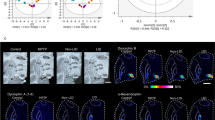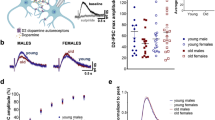Abstract
Antischizophrenic neuroleptic drugs interact with brain dopamine systems in producing both therapeutic and unwanted side effects1. Short-term administration of neuroleptics may produce a parkinsonian, hypokinetic syndrome mimicking symptoms of dopamine depletion, and presumably caused by dopamine receptor blockade2. Paradoxically, some 20% of patients treated chronically with these agents develop tardive dyskinesia. The adventitious movements typical of this condition mimic symptoms of dopamine excess despite continuing receptor blockade3–5. Dopamine receptor supersensitivity does develop in such conditions, but its extent does not correlate well with the presence or absence of tardive dyskinesia6. Exploration of neuroleptic-induced alterations in other dopamine-associated systems may thus provide insight into these processes. Dopamine-containing cells of the substantia nigra, prominently implicated in the motor side effects of neuroleptics, possess dense concentrations of receptors for the putative peptide neurotransmitter, neurotensin7–9. Here we report that these receptors are substantially increased in both rats and humans after chronic treatment with neuroleptic drugs, and discuss possible implications of this finding for our understanding of neuroleptic actions.
This is a preview of subscription content, access via your institution
Access options
Subscribe to this journal
Receive 51 print issues and online access
$199.00 per year
only $3.90 per issue
Buy this article
- Purchase on Springer Link
- Instant access to full article PDF
Prices may be subject to local taxes which are calculated during checkout
Similar content being viewed by others
References
Snyder, S. H. Am. J. Psychiat. 138, 460–464 (1981).
Hornykiewicz, O. Advances in Neurology Vol. 9 (eds Calne, D. B., Chase, T. N. & Barbeau, A.) 155–165 (Raven, New York, 1975).
Baldessarini, R. J. Am. J. Psychiat. 137, 1163–1172 (1980).
Kane, J. M. & Smith, J. M. Archs gen. Psychiat. 39, 473–481 (1982).
Kazamatsuri, H., Chien, C.-P. & Cole, J. O. Archs gen. Psychiat. 27, 491–499 (1972).
Crow, T. J. et al. J. clin. Psychopharmac. 2, 336–340 (1982).
Young, W. S. III & Kuhar, M. J. Brain Res. 206, 273–285 (1981).
Palacios, J. M. & Kuhar, M. J. Nature 294, 587–589 (1981).
Uhl, G. R., Whitehouse, P., Price, D. & Kuhar, M. J. Neurology (in the press).
Uhl, G. R., Bennett, J. P. Jr & Snyder, S. H. Brain Res. 130, 299–313 (1977).
Uhl, G. R., Goodman, R. R. & Snyder, S. H. Brain Res. 167, 77–91 (1979).
Uhl, G. R., Kuhar, M. J. & Snyder, S. H. Proc. natn. Acad. Sci. U.S.A. 74, 4059–4063 (1977).
Ibata, Y. et al. Brain Res. 269, 177–179 (1983).
Uhl, G. R. et al. Neurosci. Abstr. 8, 152 (1982).
Haubrich, D. R., Martin, G. E., Pflueger, A. B. & Williams, M. Brain Res. 231, 216–221 (1982).
Andrade, R. & Aghajanian, G. K. Neurosci. Abstr. 7, 573 (1981).
DeQuidt, M. E. & Emson, P. C. Brain Res. 274, 376–380 (1983).
Burt, D. R., Creese, I. & Snyder, S. H. Science 196, 326–328 (1977).
Palacios, J., Niehoff, D. & Kuhar, M. J. Brain Res. 213, 277–289 (1981).
Mazella, J. et al. J. biol. Chem. 258, 3476–3481 (1983).
Chang, R. S. L., Lotti, V. J., Martin, G. E. & Chen, T. B. Life Sci. 32, 871–878 (1983).
Benes, F. M., Paskevich, P. A. & Domesick, V. B. Science 221, 969–971 (1983).
Pickel, V. M., Joh, T. H., Reis, D. J., Leeman, S. E. & Miller, R. J. Brain Res. 160, 387–400 (1979).
Hunt, S. P., Kelley, J. S. & Emson, P. C. Neuroscience 5, 1871–1890 (1980).
DiFiglia, M., Aronin, N. & Leeman, S. E. Brain Res. 233, 381–388 (1981).
Pickel, V. M., Reis, D. J. & Leeman, S. E. Brain Res. 122, 534–540 (1977).
Nemeroff, C. B., Youngblood, W. W., Manberg, P. J., Prange, A. J. Jr & Kizer, J. S. Science 221, 972–975 (1983).
Govoni, S., Hong, J. S., Yang, H.-H. T. & Costa, E. J. Pharmac. exp. Ther. 215, 413–417 (1980).
Author information
Authors and Affiliations
Rights and permissions
About this article
Cite this article
Uhl, G., Kuhar, M. Chronic neuroleptic treatment enhances neurotensin receptor binding in human and rat substantia nigra. Nature 309, 350–352 (1984). https://doi.org/10.1038/309350a0
Received:
Accepted:
Issue Date:
DOI: https://doi.org/10.1038/309350a0
This article is cited by
-
Association Between Neurotensin Receptor 1 (NTR1) Gene Polymorphisms and Schizophrenia in a Han Chinese Population
Journal of Molecular Neuroscience (2013)
-
Chronic, but not acute, dosing of antipsychotic drugs alters neurotensin binding in rat brain regions
British Journal of Pharmacology (2000)
-
Autoradiographic characterization of neurotensin receptors in the entorhinal cortex of schizophrenic patients and control subjects
Journal of Neural Transmission (1995)
-
Oxygen isotope heterogeneity of the mantle deduced from global 18O systematics of basalts from different geotectonic settings
Contributions to Mineralogy and Petrology (1995)
Comments
By submitting a comment you agree to abide by our Terms and Community Guidelines. If you find something abusive or that does not comply with our terms or guidelines please flag it as inappropriate.



